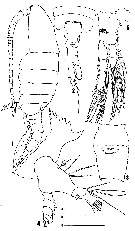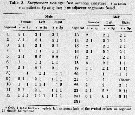|
|
 |
|
Calanoida ( Order ) |
|
|
|
Diaptomoidea ( Superfamily ) |
|
|
|
Temoridae ( Family ) |
|
|
|
Eurytemora ( Genus ) |
|
|
| |
Eurytemora richingsi Heron & Damkaer, 1976 (F,M) | |
| | | | | | | Ref.: | | | Heron & Damkaer, 1976 (p.128, Descr.F,M, figs.F,M); Kos, 2016 (p.91, figs. 49, figs.F,M, Rem.) |  issued from : G.A. Heron & D.D. Damkaer in Proc. Biol. Soc. Wash., 1976, 89 (8). [p.130, Figs.1-5]. Female (from 83°14', 153°48'-154°02'W): 1, habitus (left lateral); 2, posterior of prosome and urosome (dorsal); 3, genital segment (ventral); 4, right Md; 5, P1 (anterior). Scale bars: 0.10 mm.; a : figs. 1, 2; b: figs. 3, 5; c: fig. 4. Nota : - A1 25-segmented, segments 8-9 and 24-25 with incomplete sutures. - Md with wide gap on blade separating outer denticle, hyaline setules between anda t bases of some denticles and anterior edge ; - A2, Mx1, Mx2 , and Mxp with setation and segmentation typical for the genus. - P1 atypical for the genus : endopod with 8 instead of 6 setae, and incipient segmentation on anterior surface, anterodistal cluster of setules on 1st basipod. - Caudal rami length about equal to that of anal segment, inner marginal hairs.
|
 issued from : G.A. Heron & D.D. Damkaer in Proc. Biol. Soc. Wash., 1976, 89 (8). [p.132, Figs.6-10]. Female: 6, P2 (anterior); 7, P3 (anterior); 8, P4 (anterior); 9, P5 (anterior); 10, left P5 (posterior). Scale bars: b (figs. 6-9); c (fig. 10). Nota : P2 to P4 with setation and segmentation typical for the genus P5 with outer sclerotized margins, conspicuous at posterior articulation of exopod ; 1st exopod with 2 finely barbe douter spines ; robust inner spinous process with anterior and posterior row of short spinules ; exopodal segment 2 small, oval, with 2 outer and 1 terminal finely barbed, sinuate spines, 2 delicate setules on inner margin.
|
 issued from : G.A. Heron & D.D. Damkaer in Proc. Biol. Soc. Wash., 1976, 89 (8). [p.134, Figs.11-17]. Male: 11, habitus (right lateral); 12, urosome (dorsal); 13, right A1 (segments 4-12, spine solid); 14, right A1 (segment 16); 15, P5 (anterior); 16, P5 (posterior); 17, left P5 (2nd exopodal segment, anterior). Scale bars: a (figs. 11, 12); b (figs.15, 16); c (figs.17); d (figs 13, 14). d = 0.10mm. Nota : - A2, Md, Mx1, Mx2, and Mxp like those of female. - P1 to P4 similar to those of female. - P5 with 1st basal segments fused left to right ; left ramus 3-segmented, exopodal segment 2 with distinctive mitten shape with 2 outer spines and 2 spines on the articulated thumb, dense clusters of setules on distal surfaces ; right ramus 4-segmented. Several other Eurytemora species have bulbous projections on the left terminal exopod, but none is described as being articulate.
|
 issued from : G.A. Heron & D.D. Damkaer in Proc. Biol. Soc. Wash., 1976, 89 (8). [p.133, Table 3]. Armature setation of A1 female and male.
| | | | | Compl. Ref.: | | | Kosobokova & al., 1998 (tab.2); Kosobokova & al., 2011 (p.29, Table 2, Rem.: Arctic Basins) | | | | NZ: | 1 | | |
|
Distribution map of Eurytemora richingsi by geographical zones
|
| | | | Loc: | | | Arctic ( Fletcher's Ice Island, Laptev Sea, Nansen Basin, Amundsen Basin, Canada Basin)
Type locality: 83°14' N, 153°48' W. | | | | N: | 4 | | | | Lg.: | | | (568) F: 1,8-1,68; M: 1,56-1,4; {F: 1,68-1,80; M: 1,40-1,56} | | | | Rem.: | marine. Cryopelagic (ice-associated).
Incomplete data.
After Heron & Damkaer (1976, p.127), Gurney (1931) suggested that Eurytemora may have evolved from the marine genus Temora in the ''arctic sea of glacial times''.
For Heron & Damkaer (1976, Table 2) ratio anal somite/uropod (= caudal rami) = 1/1; without metasomal wings. Collected between 500-3000 m and surface. Salinities (p.1000) : depth 34.607 (275 m) to 34.927 (450 m) and 34.886 (1000 m). E. pacifica, velox, wolterecki have such short uropods in relation to the anal segment. In E. richingsi, P1 endopod differs from these species with the presence of an outer seta and an additional inner seta. | | | Last update : 30/04/2020 | |
|
|
 Any use of this site for a publication will be mentioned with the following reference : Any use of this site for a publication will be mentioned with the following reference :
Razouls C., Desreumaux N., Kouwenberg J. and de Bovée F., 2005-2025. - Biodiversity of Marine Planktonic Copepods (morphology, geographical distribution and biological data). Sorbonne University, CNRS. Available at http://copepodes.obs-banyuls.fr/en [Accessed December 25, 2025] © copyright 2005-2025 Sorbonne University, CNRS
|
|
 |
 |







